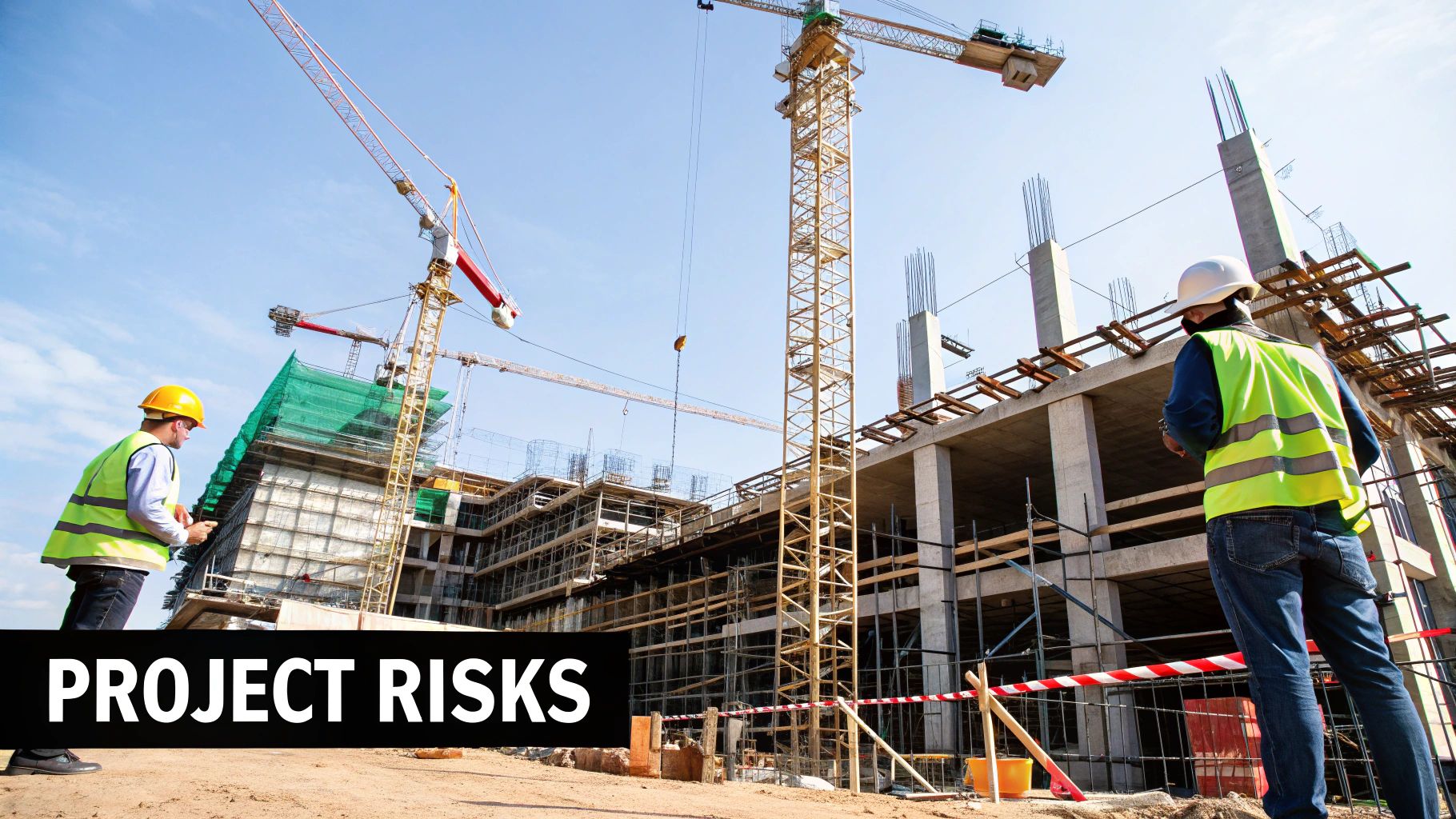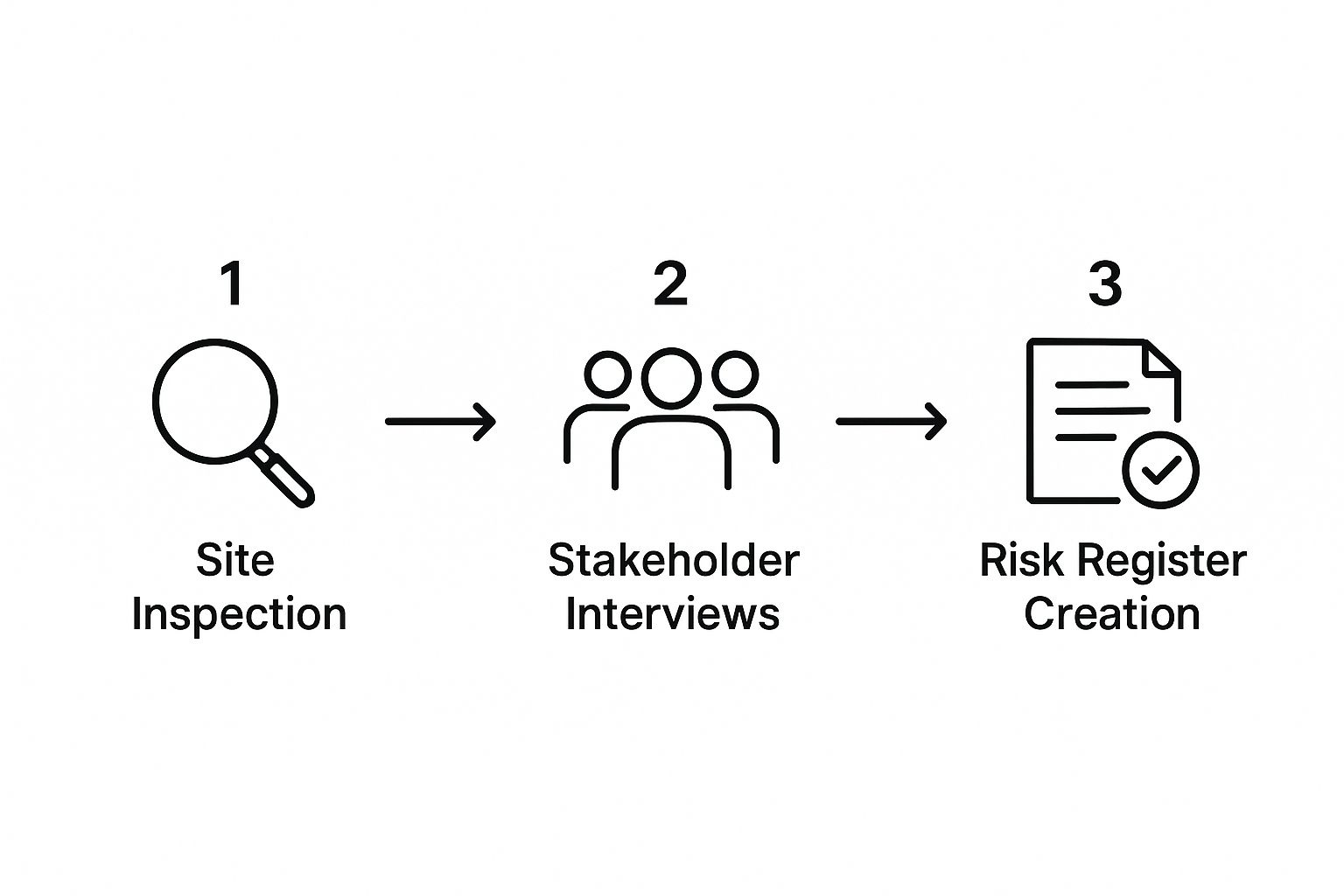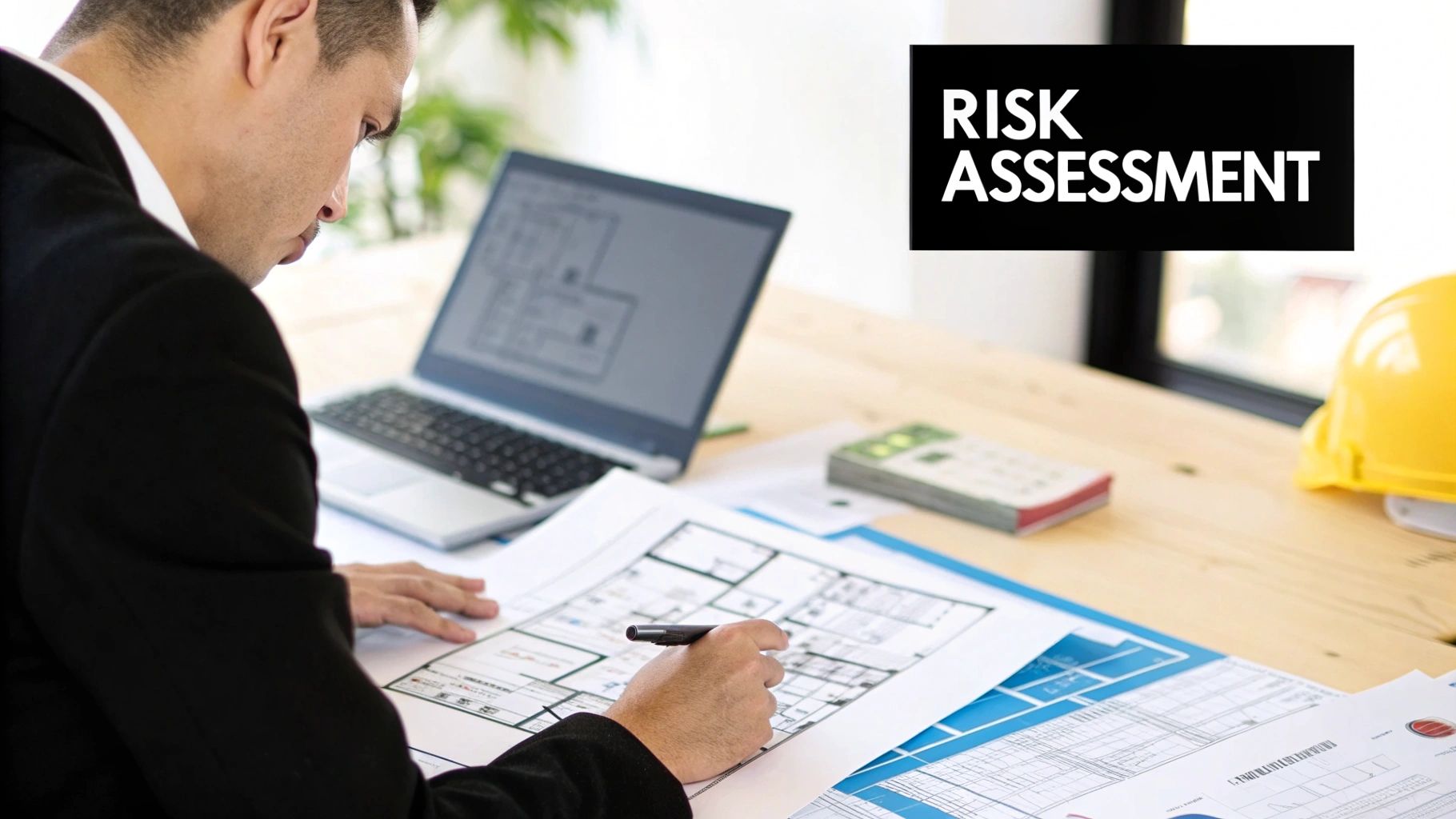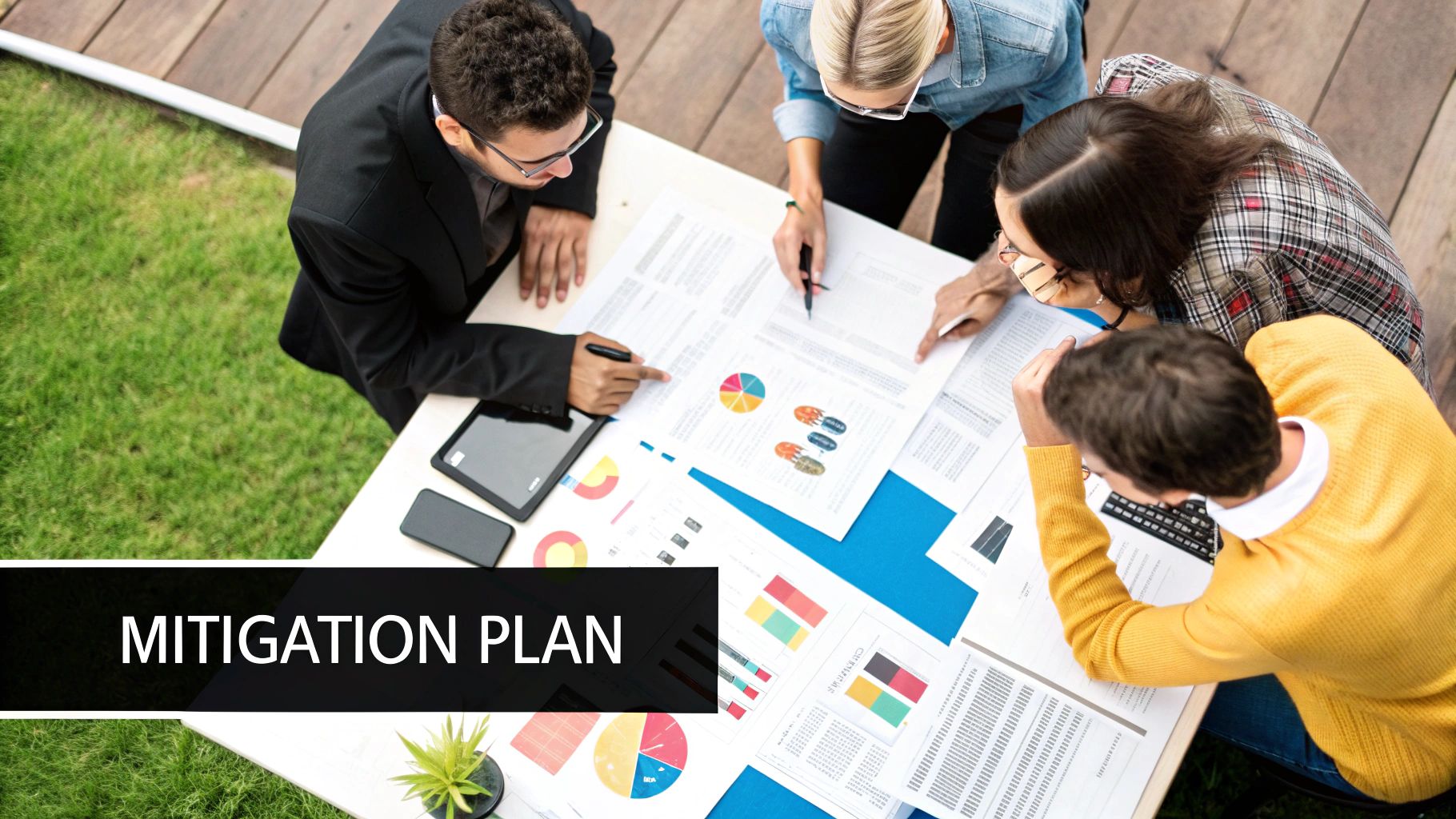For a startup founder, building out a new office, warehouse, or retail space is one of the highest-stakes projects you will ever undertake. Construction project risk management isn't just industry jargon—it's a critical operational discipline. It's the structured process of identifying, assessing, and neutralizing threats that could derail your project's budget, timeline, and quality, directly impacting your startup's growth trajectory and investor confidence.
This guide provides a practical framework for founders to navigate the complexities of a build-out, turning a potential liability into a strategic advantage.
Why Risk Management Is a Founder's Responsibility

As a founder, a physical expansion is never just a construction project; it's a critical component of your startup's growth strategy. You wouldn’t launch a new software feature without rigorous testing and a clear go-to-market plan. The same logic applies here: you can’t break ground without a robust plan for managing the unexpected.
Many founders are experts in their domain—be it SaaS, biotech, or e-commerce—but newcomers to the world of concrete, steel, and permits. This knowledge gap creates significant blind spots, making a physical build-out one of the riskiest ventures a young company can undertake.
The Project as a High-Stakes Launch
Treat your construction schedule like your go-to-market strategy. A delay in securing a building permit is functionally identical to a show-stopping bug discovered the night before a product launch. A sudden spike in steel prices? That’s no different than your customer acquisition cost doubling overnight. Both scenarios burn through cash reserves and can stall your startup's momentum.
This is a sobering thought, especially when considering that studies, like those from McKinsey, frequently show that a majority of large construction projects run over budget. That's a statistic that should command the attention of any founder managing a tight runway.
A construction project is a direct reflection of a founder's operational discipline. Proactively managing its risks demonstrates the kind of foresight and accountability that investors value, signaling that their capital is in capable hands.
This is why managing construction risk isn't a task you can simply delegate and forget. It is a strategic function demanding your oversight. Getting it right ensures your new facility becomes an asset that supports your business model, rather than a liability that drains it.
Key Reasons Founders Must Master This Skill
For an entrepreneur, the consequences of a poorly managed construction project ripple far beyond the job site. Effective risk management directly impacts the health and valuation of your entire startup.
- Protect Your Capital: It prevents budget overruns from siphoning funds away from core growth activities, like hiring key talent or executing your marketing strategy.
- Maintain Investor Confidence: It proves to your board and backers that you are a responsible steward of capital who can manage complex, high-stakes operations beyond your core product.
- Build Operational Resilience: It ensures your new facility is operational on schedule, allowing you to scale production, serve customers, and generate revenue as projected in your business plan.
- Enhance Founder Credibility: Successfully delivering a major capital project on time and on budget sends a powerful signal of founder excellence. It builds trust with partners, future investors, and your team.
Ultimately, by taking ownership of this process, you transform a significant potential liability into a genuine strategic advantage. You're not just building a structure; you're ensuring your startup’s physical foundation is as robust as its business model.
A Four-Step Framework for Managing Project Risks
You cannot predict the future of a construction project, but you can implement a repeatable process to handle the inevitable challenges. For a founder juggling countless priorities, this four-step framework transforms the daunting concept of "risk management" into a practical, step-by-step strategy to protect your capital and timeline.
This framework is built on four pillars: Identification, Assessment, Response, and Monitoring. Each stage systematically moves you from discovering threats to deciding what to do about them and maintaining vigilance as the project unfolds.
Step 1: Risk Identification
First, you must understand what you’re up against. You cannot manage a risk you haven’t identified. This initial stage is about discovery and documentation, not immediate problem-solving. Your objective is to create a comprehensive risk register—a master list of everything that could potentially compromise your project's budget, schedule, or quality.
Imagine your startup is building its first dedicated headquarters. During the identification phase, your project team would brainstorm potential issues. The list might include:
- A skilled labor shortage in the region could halt critical plumbing or electrical work.
- The discovery of unexpected soil contamination during excavation would trigger costly remediation and significant delays.
- The local planning department has a reputation for permit approval delays, pushing back your start date.
- Volatile material prices—such as a sudden surge in steel costs—could compromise your budget.
This process is not guesswork. It should be a structured effort combining team brainstorming, analysis of data from similar projects, and thorough pre-construction site inspections. The goal is to cast a wide net.

By starting with physical site conditions, adding your team's experiential knowledge, and formalizing it all in a shared document, you create the foundation for your entire risk management strategy.
Step 2: Risk Assessment
With a comprehensive list of potential issues, the next step is to prioritize. Not all risks are created equal. The assessment phase is where you analyze each risk based on two critical dimensions:
- Probability: How likely is this to occur?
- Impact: If it occurs, how severe will the consequences be for the project and the business?
This exercise is about focusing your limited time and resources on the most significant threats. A minor delay in paint delivery (low impact) is an annoyance; a major structural flaw in the design (high impact) is a potential catastrophe.
The core of risk assessment is separating the "noise" from the "danger." A founder's time is their most valuable asset, and this step ensures it's spent neutralizing the threats that could genuinely jeopardize the project and the business.
Revisiting our headquarters example, let's analyze the "skilled labor shortage." After reviewing local market data, you might classify its probability as "medium" but its impact as "high," as it could delay your move-in date by months, disrupting operations and revenue generation. This risk immediately becomes a top priority.
Common Construction Risks and Proactive Mitigation Strategies
For founders embarking on their first major build, knowing where to start can be challenging. This table outlines common risks and provides a framework for proactive mitigation—a key element of Best Business Practices.
| Risk Category | Specific Risk Example | Potential Startup Impact | Initial Mitigation Strategy |
|---|---|---|---|
| Financial Risks | Sudden increase in material costs (e.g., steel, lumber). | Budget overruns, potentially requiring new financing or scope cuts. | Lock in prices with suppliers early; build a 10-15% contingency into the budget. |
| Schedule Risks | Delays in receiving municipal permits or inspections. | Pushes back the entire project timeline, increasing carrying costs. | Submit applications well in advance; maintain regular communication with officials. |
| Labor Risks | Shortage of specialized trades (e.g., electricians, welders). | Work stoppages, delayed project phases, and increased labor costs. | Have your general contractor confirm subcontractor availability and staffing plans. |
| Site-Related Risks | Discovery of unforeseen ground conditions (e.g., rock, poor soil). | Requires expensive excavation or foundation redesign, causing major delays. | Conduct thorough geotechnical surveys and site investigations before finalizing design. |
| Design Risks | Errors or omissions in the architectural or engineering plans. | Costly rework during construction (change orders), potential safety issues. | Engage an independent third-party to conduct a peer review of all design documents. |
While this list is not exhaustive, it covers major risk categories. Addressing these potential issues upfront is far more cost-effective and less disruptive than reacting to them after they materialize.
Step 3: Risk Response Planning
Now that you have identified and prioritized your risks, it's time to create a game plan. What specific actions will you take for each major threat? Your risk response plan outlines these proactive measures.
For the high-priority labor shortage risk, your response plan might include several strategies:
- Mitigation: Instruct your general contractor to secure binding contracts with key subcontractors far in advance.
- Contingency: Build extra "float" time into the project schedule around phases dependent on these specialized trades.
Crafting these plans is a critical exercise in strategic foresight. For more insights on managing project timelines and deliverables, explore our guides on startup project management.
Step 4: Risk Monitoring and Control
Risk management is not a one-time event; it's a continuous process throughout the project's lifecycle. You must constantly monitor your risk register, track the effectiveness of your response plans, and scan for new threats that may emerge.
Regular risk review meetings with your project team are non-negotiable. These check-ins are your opportunity to assess if your strategies are working, adjust your approach as needed, and maintain a high level of vigilance across the team.
For instance, if market intelligence suggests the labor market is tightening further, you might activate a more aggressive response, such as authorizing overtime or sourcing crews from an adjacent region. This constant vigilance keeps your plan relevant and effective, ensuring a smoother path from groundbreaking to grand opening.
How to Identify and Prioritize Your Project Risks

Effective risk management is about preparation, not pessimism. For a founder overseeing a construction project, the first step is to anticipate what could go wrong long before it does. By systematically identifying and ranking threats, you can strategically allocate your limited resources where they will have the greatest impact.
The goal is to move beyond vague anxieties to a concrete, documented list of potential problems. This requires a collaborative effort, combining brainstorming, data analysis, and leveraging the experience of seasoned professionals. This living document will capture every potential challenge, no matter how minor it may initially seem.
Uncovering Potential Threats
The most effective way to identify risks is to approach them from multiple angles to avoid blind spots. A robust identification process employs several techniques to ensure a thorough search.
Here are a few practical methods to start:
- Dedicated Brainstorming: Assemble your core team—the general contractor, architect, and key internal stakeholders. The sole agenda item is to list every conceivable event that could derail the project. No idea is too small at this stage.
- Consult Industry Veterans: Seek advice from other founders, mentors, or advisors in your network who have managed a build-out. Their real-world experiences are invaluable for uncovering "unknown unknowns"—the risks you wouldn't even know to look for.
- Utilize Checklists: You don't have to reinvent the wheel. Use industry-standard checklists that categorize common risks. These tools can help ensure you haven't overlooked an entire area of vulnerability.
This structured approach is the foundational step toward building a resilient project plan.
Organizing Risks with a Breakdown Structure
Once you have a long list of potential issues, it's time to impose order. A Risk Breakdown Structure (RBS) is a simple hierarchical chart that groups similar risks together. It transforms a scattered list into a clear, organized map of your project's vulnerabilities.
For example, your RBS might have these primary categories:
- Financial Risks: Budget overruns, unexpected financing costs, or volatile material prices.
- Logistical Risks: Supply chain disruptions, equipment failure, or site access problems.
- Regulatory Risks: Failed inspections, permit denials, or changes in zoning laws.
- Environmental Risks: Severe weather events, or the discovery of hazardous materials on-site.
Organizing risks this way simplifies analysis and helps in assigning ownership for each category. It also enables you to communicate potential challenges to your investors and board with greater clarity. The project delivery method you choose also introduces unique risks, which is why it's critical to understand different construction project delivery methods early in the process.
Using a Probability-Impact Matrix
With your risks identified and organized, the next step is to determine which ones demand your immediate attention. A probability-impact matrix is a simple yet powerful tool for this purpose. It helps you visually categorize each risk based on its likelihood of occurring and the severity of its potential impact.
You plot each risk on a grid where "Probability" (low to high) is one axis and "Impact" (low to high) is the other. This exercise immediately clarifies your priorities.
A risk matrix forces you to distinguish between minor annoyances and true project killers. Your primary attention and resources must be directed toward the high-probability, high-impact quadrant—these are the threats that can sink your startup's expansion plans.
For example, a slight delivery delay for non-essential finishes might be a high-probability, low-impact event. You document it, but it doesn't require an emergency response.
Conversely, discovering a major flaw in the structural design is a low-probability but extremely high-impact risk. This threat demands an immediate and thorough response plan because the consequences could be catastrophic for your timeline, budget, and even your company's viability.
By mapping your risks, you create a clear roadmap for your response strategy, moving from a state of general concern to strategic, focused action.
Building a Resilient Risk Response Plan

You've identified the risks and prioritized them. Now, you must decide precisely what you will do about them. This is the essence of a risk response plan.
Think of this as your team's playbook for managing challenges before they escalate. It translates analysis into clear, decisive actions that protect your startup's capital and schedule. For a founder, this isn't about creating a cumbersome manual; it's about establishing clear, pre-agreed strategies for major threats so you can lead with confidence and agility.
The Four Core Risk Response Strategies
For any given risk, there are four primary strategies you can employ. The right choice depends on the specific threat and your startup's risk tolerance.
-
Avoid: The most direct approach—change the plan to eliminate the risk entirely. For instance, if a specific imported material is subject to volatile pricing and shipping delays, you can work with your architect to specify a readily available domestic alternative, designing the risk out of the project from the start.
-
Mitigate: Your most common strategy. You can't eliminate the risk, so you take actions to reduce its probability or lessen its impact. Pre-purchasing steel to lock in prices is a classic mitigation tactic against market volatility.
-
Transfer: This strategy shifts the financial consequences of a risk to a third party. The primary tool for this is insurance. Ensuring your general contractor has robust liability and builder's risk insurance is a non-negotiable part of Founder Excellence. This transfers specific financial liabilities from your startup's balance sheet.
-
Accept: Sometimes, a risk is so small or its probability so low that the cost of mitigation outweighs the potential impact. In these cases, you make a conscious decision to do nothing, accepting the potential consequences and dealing with them if they arise.
Understanding these four options elevates your strategic conversations with the project team, shifting the focus from simply identifying problems to proactively engineering solutions.
Establishing Financial and Schedule Buffers
No plan is perfect. Despite your best efforts, unforeseen issues will arise. This is where establishing a contingency is a sign of experienced leadership, not a lack of confidence.
A contingency fund is a dedicated portion of the budget set aside for unexpected costs. Industry standard is typically 5% to 10% of the total construction cost. When communicating this to your investors, frame it with strategic intent.
A contingency fund isn’t "extra money"—it's a planned buffer that demonstrates fiscal responsibility. It shows investors you understand that uncertainty is a part of construction and have a mature strategy to manage it without seeking emergency capital.
The same principle applies to your timeline. A schedule contingency, often called "float," is extra time built into the project plan. If one phase is delayed by a week, this buffer can absorb the impact without delaying the final completion date, giving you crucial operational flexibility.
Verifying and Transferring Contractor Risk
One of a founder's most powerful risk transfer tools is the contract signed with the general contractor. This legal document is your primary line of defense, but its strength depends on the reliability of the counterparty.
This is why verifying your contractor's credentials is a critical step in construction project risk management. You must confirm they have adequate insurance, are properly bonded, and hold all necessary licenses. Our guide on contractor license verification in California offers a framework that can be adapted for any jurisdiction.
This due diligence is a fundamental aspect of operational management. It transfers a significant amount of liability from your startup to the party best equipped to manage it—your contractor.
Leveraging Technology for Smarter Risk Management
https://www.youtube.com/embed/jfaABy0E6r4
Using spreadsheets to manage risk on a complex construction project is like navigating with a paper map in the age of GPS. For founders who leverage data to drive every other aspect of their business, applying the same data-driven mindset to a build-out is essential.
Modern technology is revolutionizing construction project risk management, transforming it from a reactive, administrative task into a proactive, data-fueled strategy. Digital tools provide a real-time, centralized view of your project's health, enabling you to identify emerging issues early, make more informed decisions, and ensure seamless team alignment.
Centralizing Risk with Project Management Software
The foundation of a modern risk strategy is a single source of truth. Construction project management platforms like Procore create a central hub for all project information—from blueprints and daily field reports to change orders and the official risk register.
This centralization prevents critical data from being lost in email chains or isolated on individual laptops. When the entire team operates from the same live information, communication improves, accountability is clear, and risks have nowhere to hide. This transforms a fragmented process into a coordinated, strategic effort.
A centralized dashboard gives founders and project managers the ability to monitor key performance indicators at a glance, enabling faster, data-backed decisions to mitigate risks before they escalate. This is a prime example of Technology Best Practices for modern startups.
The Rise of AI and Predictive Analytics
Beyond simple organization, the real game-changer is the application of artificial intelligence and predictive analytics. These are no longer just buzzwords; they are becoming essential tools for managing the immense complexity of a modern construction project.
AI algorithms can analyze vast datasets—including historical project outcomes, labor productivity, supply chain logistics, and even weather forecasts—to identify patterns and predict potential issues that a human might miss. This predictive capability provides a significant strategic advantage.
"A founder's greatest asset is foresight. Predictive analytics in construction provides a data-backed crystal ball, transforming risk management from a guessing game into a strategic discipline."
For example, an AI tool might flag a subcontractor with a history of delays on similar projects, prompting you to implement enhanced oversight from day one. As detailed by industry sources, the construction sector is increasingly using AI to get ahead of risks, analyzing data to predict supply chain disruptions or equipment failures, allowing managers to proactively adjust plans and avoid costly overruns. You can find more details on how construction firms are proactively mitigating risk on cmicglobal.com.
By integrating these AI tools for startups into your project management toolkit, you shift from reactive firefighting to proactive problem-solving. This is how you keep your project on track and protect your startup’s investment.
Frequently Asked Questions
As a founder, navigating a major construction project introduces a new set of complex challenges. Here are answers to some of the most common questions about managing construction risk.
What Is the Single Biggest Risk for a Startup in a Construction Project?
Unequivocally, it's budget overruns. While every project has unique risks, this is the one that poses the most direct threat to a startup's viability. Startups operate on carefully allocated capital, and every dollar is earmarked for growth. When construction costs escalate, that capital must be diverted from core business functions like product development, marketing, or hiring.
A 20% cost overrun isn't just an accounting issue; for a startup, it could mean forgoing a critical hire or slashing the marketing budget, directly impacting your growth targets. The best defense is a meticulously planned budget with a robust contingency fund—typically 10-15% of the total project cost—established from the outset.
How Do I Manage Project Risks Without a Construction Background?
You don't need to be a construction expert. As a founder, your core competency is leadership, which includes assembling a world-class team and asking the right questions. Your primary role is to hire trusted experts—a reputable general contractor, an experienced project manager—and then manage them effectively.
Use the frameworks in this guide to drive strategic conversations. Ask pointed questions like:
- "What are our top five risks as of this week, and what is our mitigation plan for each?"
- "What is the contingency plan if our custom millwork is delayed?"
- "Based on our current risk register, is our contingency fund still adequate?"
Your job is to provide strategic oversight and facilitate informed decision-making, not to personally manage day-to-day site operations.
When Should We Start the Risk Management Process?
From the very beginning. Risk management should commence during the earliest planning stages—the feasibility study and conceptual design phase—long before you break ground.
Identifying risks early is crucial because they are exponentially cheaper and easier to address at this stage. For example, discovering a zoning conflict before signing a lease is a minor pivot; discovering it after purchasing the property can be a catastrophic financial loss. Integrating risk management from day one embeds resilience into the project's DNA.
Is Risk Management Just About Creating a Contingency Fund?
No. A contingency fund is an essential safety net, but it is fundamentally a reactive tool designed to absorb the impact of unforeseen problems.
True risk management is proactive. It is the systematic process of looking ahead, identifying potential obstacles, and developing strategies to avoid them or minimize their impact before they affect your budget or schedule. The primary goal is not just to have capital available when things go wrong, but to prevent as many things as possible from going wrong in the first place.
At Spotlight on Startups, our mission is to provide founders with the practical insights and frameworks needed to build resilient, high-growth companies. For more expert guidance on startup growth strategies, fundraising, and leadership, explore our full range of resources for founders.